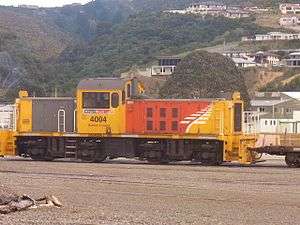New Zealand DSJ class locomotive
The New Zealand DSJ class is a class of diesel-electric shunting locomotive used on the New Zealand rail network. The class has a very similar overall design to the DSG class, but is instead single-engined, has a cab that is offset from the centre and is both shorter and lighter than its twin-engined counterpart.
| New Zealand DSJ class | |||||||||||||
|---|---|---|---|---|---|---|---|---|---|---|---|---|---|
 DSJ 4004 in Picton, April 2012. | |||||||||||||
| |||||||||||||
| |||||||||||||
| |||||||||||||
Introduction

The first DSJ was assembled in Japan by Toshiba Heavy Industries in 1983 and arrived in New Zealand in 1984.[1] Toshiba are the same company who built the EO class electric locomotives. The remaining four were assembled at the former Addington Workshops in Christchurch,[2] and entered service from 1984 to 1985.[1]
With only five members in this class, it represents one of the smallest contingents of shunt locomotives in current use.
In Service
The locomotives have spent most of their time in user at the Te Rapa Marshalling Yard and Picton, and have ventured else where on the network from time to time, including Ahuriri in Napier.[2]
References
- "DSJ Toshiba, Addington, 1984". New Zealand Railways Rolling Stock Lists. Retrieved 28 February 2019.
- Parsons 2002, p. 18.
Further reading
- Parsons, David (2002). New Zealand Railway Motive Power 2002. New Zealand Railway and Locomotive Society. p. 64. ISBN 978-0-908573-78-3.